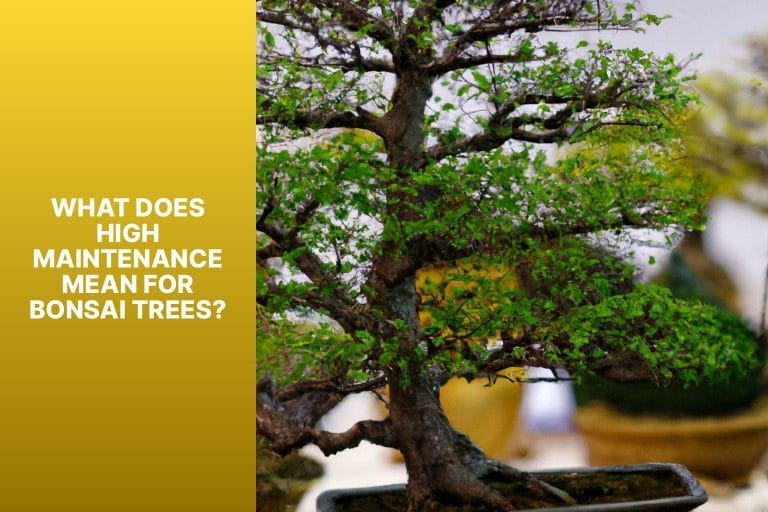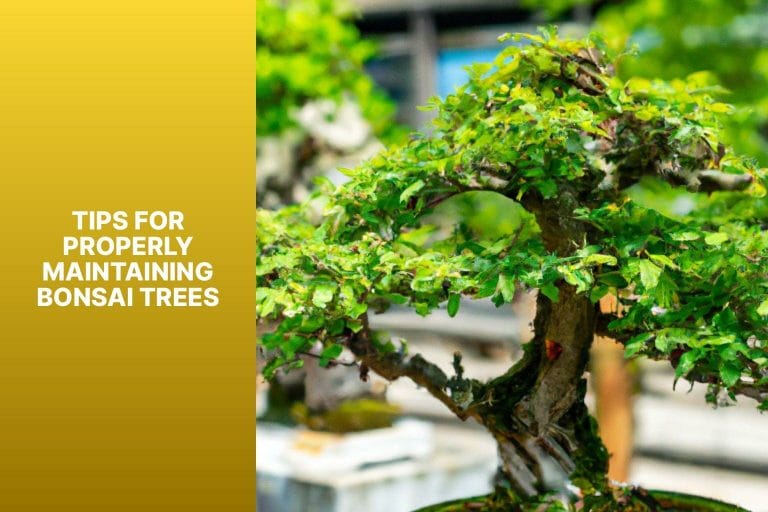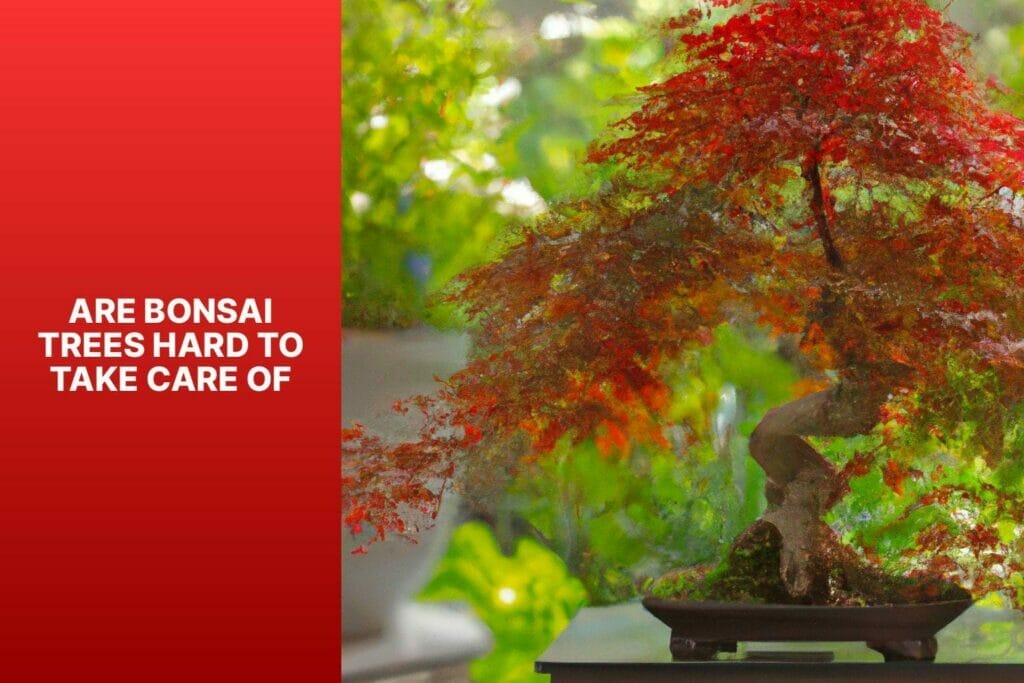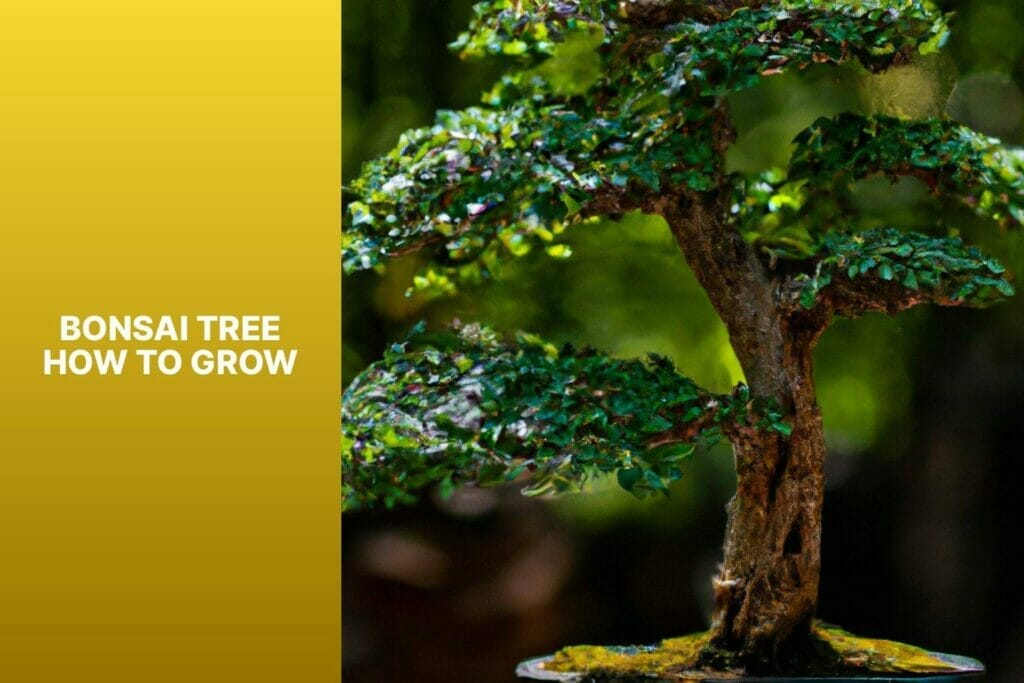Bonsai trees have a unique and captivating beauty, making them popular among enthusiasts and collectors. There is a common question among those considering bonsai trees: are they high maintenance?
In this article, we will explore the topic of bonsai tree maintenance and understand what it means for these miniature trees.
To begin with, let’s have an introduction to bonsai trees and their nature. Bonsai, originating from Japan, is the art of cultivating and nurturing miniature trees that mimic the shape and aesthetics of full-sized trees.
These small, carefully pruned, shaped trees require specialized care to maintain their beauty and health.
Understanding what high maintenance means for bonsai trees is crucial. High maintenance refers to the care and attention required to keep a bonsai tree in optimal condition.
It includes various practices and factors that influence the overall health and appearance of the tree.
Some common maintenance practices for bonsai trees include pruning and trimming to maintain the desired shape, Watering and humidity control to ensure adequate moisture levels, fertilization to provide necessary nutrients, and repotting to refresh the soil and promote root health.
Several factors determine the maintenance level of bonsai trees. The species of the tree plays a significant role, as different species have distinct care requirements.
The age and size of the bonsai tree can impact the maintenance level, with younger and smaller trees usually requiring more attention.
Environmental conditions, such as sunlight exposure and temperature, also play a role in determining the care needs of bonsai trees.
So, are bonsai trees considered high maintenance? The answer varies based on individual preferences and Experience.
Some may find the care and attention required for bonsai trees demanding, while others may enjoy the process and consider it a rewarding hobby.
To properly maintain bonsai trees, it’s essential to understand the specific needs of your tree species, regularly inspect and care for the tree, and seek expert guidance when necessary.
By following these tips, you can ensure that your bonsai tree thrives and continues to bring beauty and tranquility to your surroundings.
In the rest of this article, we will delve deeper into the various maintenance practices and factors that influence the care of bonsai trees, providing a comprehensive understanding of how to care for these enchanting miniature trees.
Key takeaway:
- Bonsai trees require regular maintenance: Maintaining bonsai trees involves various practices such as pruning, Watering, fertilization, and repotting. Understanding and fulfilling the specific needs of your bonsai tree is crucial for its health and longevity.
- Maintenance level depends on several factors: The maintenance level of bonsai trees is influenced by factors like the species of the tree, its age and size, and the environmental conditions it is exposed to. These factors determine the amount of care and attention required.
What Does High Maintenance Mean for Bonsai Trees?

Photo Credits: Mnbonsainetwork.Com by Timothy Williams
“What Does High Maintenance Mean for Bonsai Trees?
High maintenance for bonsai trees means regular and diligent care is necessary for them to thrive. Bonsai trees are living art forms that demand attention and effort to maintain beauty and health.
Proper Watering, pruning, shaping, and fertilizing are crucial for their size, form, and nutrient needs. Bonsai trees also need protection from extreme temperatures and pests.
Attention to the tree’s environment, including sunlight exposure and humidity levels, is essential for their well-being. Regular monitoring and adjustment of these factors are required to keep bonsai trees healthy.
Neglecting any of these care tasks can quickly result in the decline or death of the tree. Therefore, a high level of maintenance is necessary to ensure the longevity and beauty of bonsai trees.”
What Factors Influence the Maintenance Level of Bonsai Trees?
Different species of bonsai trees require varying levels of maintenance. Some species are more resilient and require less frequent care, while others may be more delicate and require more attention.
The age and size of bonsai trees also play a role. Younger trees generally require more maintenance compared to older ones. As bonsai trees grow and mature, they become more self-sustaining and require less frequent care.
Environmental conditions, such as temperature, humidity, and light, greatly influence the maintenance level of bonsai trees. Some species thrive in specific environments, while others require more controlled conditions.
Personal Experience: I had a Juniper bonsai tree that needed frequent Watering and pruning to keep its shape and health. When I moved to a new location with different environmental conditions, the maintenance level changed.
The new location had lower humidity levels, so I had to mist and water the tree more often to keep it hydrated. I also had to provide more protection from direct sunlight because the new location had stronger exposure.
This Experience taught me the importance of considering environmental conditions when determining the maintenance level of bonsai trees.
Common Maintenance Practices for Bonsai Trees
Discover the secrets to keeping your bonsai trees healthy and thriving with these common maintenance practices. From precise pruning and trimming techniques to mastering watering and humidity control, we’ll dive into the essentials of bonsai tree care.
Get ready to learn about the importance of fertilization and the art of repotting as we uncover the keys to maintaining the perfect balance for these miniature works of art.
1. Pruning and Trimming
Pruning and trimming are essential for maintaining bonsai trees’ health and aesthetic appeal.
1. Pruning: Regularly pruning your bonsai tree helps maintain its shape and size. It involves removing dead, damaged, or overgrown branches. By pruning, you redirect growth and encourage a compact and balanced canopy. Always use sharp tools and make clean cuts to prevent any harm to the tree.
2. Trimming: Trimming is crucial to maintain the shape and density of the foliage. It involves selectively removing leaves and foliage to improve airflow and sunlight penetration and reduce pests and diseases. Consider the tree’s growth pattern and overall balance when trimming.
To ensure successful pruning and trimming:
1. Always use sharp and clean tools.
2. Prune and trim for your specific bonsai tree species during the appropriate season.
3. Regularly observe the tree’s growth to determine when pruning or trimming is necessary.
4. Prioritize the tree’s health by carefully balancing branch and foliage removal.
5. Seek guidance from experienced bonsai enthusiasts or professionals for more complex tasks.
Remember, pruning and trimming are ongoing practices for the maintenance of bonsai trees. Regular attention is necessary to achieve and maintain the desired shape and appearance.
2. Watering and Humidity Control
Proper Watering and humidity control play a vital role in maintaining the health of bonsai trees. When it comes to Watering, it is essential to water the trees thoroughly but avoid over-watering.
Checking the top inch of soil and only water when it feels dry is recommended. To prevent uneven drying, ensure that the Watering is done evenly. For accurate Watering, the use of a moisture meter can be helpful.
Humidity control is also crucial for the thriving of bonsai trees. Bonsai trees prefer moderate humidity levels. One way to achieve this is by grouping trees or using a tray with water and pebbles.
Mist the foliage of the trees but be cautious not to overdo it, as excessive moisture can lead to fungal diseases.
John, an avid bonsai enthusiast, fully understood the significance of proper Watering and humidity control. He developed a personalized watering schedule for each tree, ensuring consistent moisture levels.
As a result, his trees remained healthy and vibrant, displaying minimal wilting. John utilized humidity trays with water and pebbles to enhance the humidity around his bonsai trees, improving growth and creating an appealing visual display.
John’s dedication to maintaining proper Watering and humidity control greatly contributed to the vitality and longevity of his beloved bonsai trees.
3. Fertilization
Fertilization is crucial for maintaining healthy bonsai trees. Here are the steps to fertilize your bonsai tree:
1. Choose the right fertilizer: Use a fertilizer specifically formulated for bonsai trees with balanced nitrogen, phosphorus, and potassium levels.
2. Consider the season: Adjust the fertilization schedule based on the time of year. Fertilize every two to four weeks in spring and summer and once every four to six weeks in fall and winter.
3. Measure the amount: Follow the fertilizer package instructions to determine the appropriate amount for your bonsai tree’s size and age. Avoid over-fertilizing to prevent harm.
4. Apply the fertilizer: Sprinkle it evenly on the soil surface around the tree’s base. Avoid getting fertilizer on the foliage to prevent burns.
5. Water thoroughly: After applying the fertilizer, thoroughly water the tree to ensure nutrient absorption by the roots. This prevents fertilizer burn and distributes nutrients in the soil.
6. Observe and adjust: Monitor your bonsai tree’s growth and health. Adjust the fertilization schedule or type of fertilizer if you notice nutrient deficiency or excessive growth.
Proper fertilization is crucial for the health and growth of your bonsai tree. It provides the necessary nutrients for vibrant foliage and robust root development. Follow these steps to cultivate a healthy and thriving bonsai tree.
4. Repotting
Repotting is crucial for bonsai trees to promote healthy root growth and vitality. Here, I will guide you through the steps involved in repotting your bonsai tree:
1. Select the right time: It is recommended to report during the dormant period, either in early spring or late winter.
2. Choose the right pot: Select a slightly larger pot with proper drainage holes.
3. Remove the tree from the current pot: Gently tap the sides of the pot to loosen the roots. Carefully lift the tree, preserving the root ball.
4. Prune the roots: Trim any circling or tangled roots using bonsai shears. Removing about one-third of the roots is advisable to encourage new growth.
5. Prepare the new pot: Start by adding a layer of bonsai soil at the bottom of the pot. This will help with proper drainage.
6. Position the tree in the new pot: Place the tree towards the back of the pot to create depth and visual appeal.
7. Fill the pot with bonsai soil: Ensure you fill in all the gaps around the root ball with bonsai soil, completely covering the roots.
8. Water the tree: After repotting, thoroughly water the tree to settle the soil and eliminate any air pockets.
9. Place in a suitable location: Keeping the tree in a shaded area for a few weeks after repotting is important. This will allow the tree to recover and adjust to its new environment.
Remember, repotting should be done every 2-3 years for younger trees and every 4-5 years for older trees. This practice refreshes the soil, promotes healthy root growth, and contributes to your bonsai tree’s overall health and vitality.
Factors That Determine the Maintenance Level of Bonsai Trees
Maintaining bonsai trees is a multi-faceted endeavor, and understanding the factors determining their maintenance level is key. This section uncovers what makes a bonsai tree high or low maintenance.
We’ll explore the intriguing influence of the bonsai tree species, the impact of age and size, and the critical role that environmental conditions play.
This exploration will shed light on the various aspects that enthusiasts and caretakers need to consider regarding the care and nurturing of these miniature natural wonders.
1. Species of Bonsai Tree
Species of Bonsai Tree
The different species of bonsai trees have varying maintenance requirements. Here is a table that outlines the maintenance level of some common bonsai tree species:
| Bonsai Tree Species | Maintenance Level |
| Juniper | Low |
| Japanese Maple | Moderate |
| Pine | High |
Juniper bonsai trees are hardy and can withstand various environmental conditions, making them low-maintenance options. Japanese Maple bonsai requires regular pruning and careful Watering.
Pine bonsai trees have high maintenance needs, including precise pruning techniques and specific soil requirements.
Considering the species of bonsai tree is important when choosing one, as it determines the level of maintenance required. Understanding each species’ needs ensures your bonsai tree’s growth and health.
Regularly inspect and care for your bonsai tree, seeking expert guidance when necessary to cultivate its beauty and longevity.
2. Age and Size of Bonsai Tree
The required maintenance level of a bonsai tree is determined by its age and size. To ensure tree health and development, different ages and sizes have varying needs.
| Age and Size of Bonsai Tree | Maintenance Level |
| Youthful bonsai tree (less than five years old) | Requires frequent Watering and monitoring of moisture levels. Pruning and wiring may shape the tree. I am repotting is necessary every 1-2 years for healthy root growth. |
| Mature bonsai tree (5-10 years old) | It needs regular pruning to maintain shape and promote new growth. I am watering according to specific requirements. Fertilization may be necessary. |
| Old bonsai tree (10+ years old) | Requires careful maintenance due to the potential weakening of branches and roots. Pruning removes deadwood and stimulates growth. Watering should be cautious to prevent waterlogging. Repotting should be done every 2-5 years to refresh the soil. |
Understanding the age and size of a bonsai tree is essential for proper care and maintenance. Younger trees need more attention and guidance, while older trees require monitoring and rejuvenation. Appropriate care based on age and size ensures the longevity and beauty of bonsai trees.
The remarkable characteristics of bonsai trees at different stages fascinate enthusiasts. Throughout history, the art of bonsai has captivated people worldwide with its intricacy and symbolism.
From ancient China to Japan and beyond, the cultivation and care of bonsai trees have been cherished traditions. Today, bonsai inspires patience, creativity, and appreciation for nature’s beauty in miniature form.
3. Environmental Conditions
When maintaining bonsai trees, environmental conditions are crucial. The table below outlines key factors that impact bonsai care:
| Temperature | Humidity | Light | Air Quality |
|---|---|---|---|
| Extreme temperatures can stress or kill bonsai trees. Provide the appropriate temperature range for each species. | Bonsai trees have varying humidity requirements. Adjust humidity levels accordingly for their health. | The amount of light directly affects bonsai growth. Different species have different light needs, from full sun to partial shade. | Air pollution, indoor pollutants, and chemicals can harm bonsai trees. Provide good air circulation and avoid pollutants. |
Assess and adjust these conditions to meet the specific needs of each tree species. Regular monitoring and adjustments create an ideal environment for bonsai growth and well-being.
To maintain the health and beauty of your bonsai, closely monitor temperature, humidity, light, and air quality. Create optimal conditions for your bonsai to thrive and grow into stunning miniature trees.
Are Bonsai Trees Considered High Maintenance?
Bonsai trees are indeed considered high maintenance. They require regular care and attention to maintain their small form. Several key tasks need to be carried out to ensure their optimal growth.
Pruning is essential for bonsai trees. The tree’s shape and size can be maintained by trimming branches and foliage while encouraging new growth.
Proper Watering is crucial for the health of bonsai trees. They have specific watering requirements and need regular Watering to moisten the soil.
It is important to strike the right balance, avoiding overwatering, which can lead to root rot, and underwatering, which can cause withering.
Regular fertilization is necessary for bonsai trees. This provides them with essential nutrients for healthy growth.
Repotting becomes necessary over time as bonsai trees outgrow their pots. This involves removing the tree from its container, trimming the roots, and placing it in fresh soil. Repotting ensures the tree’s health and prevents overcrowding.
Protecting bonsai trees from pests and diseases is crucial. They are vulnerable to infestations from pests like aphids and diseases like fungi. Regular inspection and timely treatment are necessary to safeguard the tree’s well-being.
Dedicating time and effort to caring for your bonsai tree is essential for its thriving. Despite the maintenance required, the rewards of owning and cultivating a bonsai tree make it all worthwhile.
Tips for Properly Maintaining Bonsai Trees

Photo Credits: Mnbonsainetwork.Com by Bobby Taylor
Properly maintaining bonsai trees is essential for their health and longevity. This section discovers some invaluable tips to keep your bonsai thriving.
From understanding your tree’s unique needs to regular care and inspection, we’ll delve into the secrets of successful bonsai maintenance.
And remember, when in doubt, seek expert guidance to ensure your bonsai receives the utmost care it deserves. Let’s dive in and unlock the art of effectively maintaining these captivating miniature trees!
1. Understand the Specific Needs of Your Bonsai Tree
Understanding the specific needs of your bonsai tree is crucial for its care and maintenance. Here are steps to help you in this process:
1. Research the species of your bonsai tree to understand its natural habitat, growth patterns, and care requirements.
2. Take note of the sunlight requirements of your bonsai tree. Some species thrive in full sun, while others prefer partial shade.
3. Familiarize yourself with your bonsai tree’s ideal temperature and humidity. Each species has different preferences for climate.
4. Gain knowledge about the watering needs of your bonsai tree. Some species require frequent Watering, while others prefer a drier environment. Improper Watering can harm your bonsai tree.
5. Consider the soil type that your bonsai tree needs. Some species require well-draining soil, while others prefer soil that retains moisture.
6. Be aware of your bonsai tree’s specific nutrient requirements. Providing nutrients at the right time can improve its health and growth.
7. Regularly observe the growth patterns and health of your bonsai tree. Be vigilant for pests, diseases, or signs of stress and take appropriate action.
Understanding the specific needs of your bonsai tree will enable you to provide proper care and maintenance for optimal growth and health.
Suggestions:
– Keep a journal to track the care and progress of your bonsai tree.
– Join bonsai enthusiast groups or forums to learn from experienced growers and share experiences.
– Consider attending workshops or classes to enhance your knowledge and skills in bonsai care.
2. Regularly Inspect and Care for Your Bonsai Tree
Regularly inspect and care for your bonsai tree to maintain its health and aesthetic appeal. Check soil moisture by gently inserting your finger to determine its moisture level.
Water the tree if the soil feels dry and wait for it to dry out if it feels wet.
Prune and trim your bonsai tree regularly to maintain its shape and encourage healthy growth. Remove any dead or diseased branches and those that disrupt the tree’s overall balance and form.
It is also important to inspect your bonsai tree for pests and diseases regularly. Look for any unusual spots or discoloration on the leaves, and watch for pests such as aphids or spider mites.
If you notice any issues, take appropriate measures to address them promptly.
Provide your bonsai tree with proper sunlight and temperature conditions. Please place it in an area with adequate sunlight, but avoid exposure to harsh afternoon sun.
Protect the tree from extreme temperature fluctuations to ensure its well-being.
Don’t forget to fertilize your bonsai tree as needed. Use a balanced liquid fertilizer formulated specifically for bonsai trees and follow the package instructions regarding frequency and dosage.
By following these steps, you can effectively maintain the health and appearance of your bonsai tree.
Let me share my personal Experience. I once had a beautiful bonsai tree and took great care of it by regularly inspecting and caring for it. During my routine inspections, I noticed white spots on the leaves.
After conducting some research, I identified it as a pest infestation. Acting quickly, I applied an organic insecticide and closely monitored the tree’s progress.
With consistent care and attention, my bonsai tree fully recovered and displayed vibrant and healthy foliage again.
3. Seek Expert Guidance when Necessary
Seeking expert guidance when necessary is crucial for maintaining bonsai trees. Experts can provide valuable knowledge and advice for ensuring the health and longevity of your bonsai tree.
They can help you understand the specific needs of your bonsai tree, including information on sunlight, water, and fertilizer requirements for your specific tree species.
When facing issues with your bonsai tree, seeking expert guidance is crucial. Experts can diagnose diseases, pests, or other problems affecting your tree and implement the right treatment or prevention measures.
Bonsai experts are skilled in pruning, shaping, wiring, and styling bonsai trees. Their guidance can teach you proper techniques to maintain the desired form of your tree and assist with repotting to ensure optimal growth and root health.
You can see expert guidance when necessary to ensure your bonsai tree receives the best care for long-term health and beauty.
Some Facts About “Are Bonsai Trees High Maintenance”:
- ✅ Bonsai trees require special care and attention. (Source: Our Team)
- ✅ Placement of the tree is important and should be based on factors such as climate and whether it is an indoor or outdoor tree. (Source: Our Team)
- ✅ Watering is the most important aspect of bonsai tree care and should be done according to the species, size of the tree, pot, time of year, soil mixture, and climate. (Source: Our Team)
- ✅ Fertilizing regularly during the growing season is crucial for the survival and health of bonsai trees. (Source: Our Team)
- ✅ Bonsai trees are confined to small pots, so proper fertilization is necessary to replenish the soil’s nutrients. (Source: Our Team)


